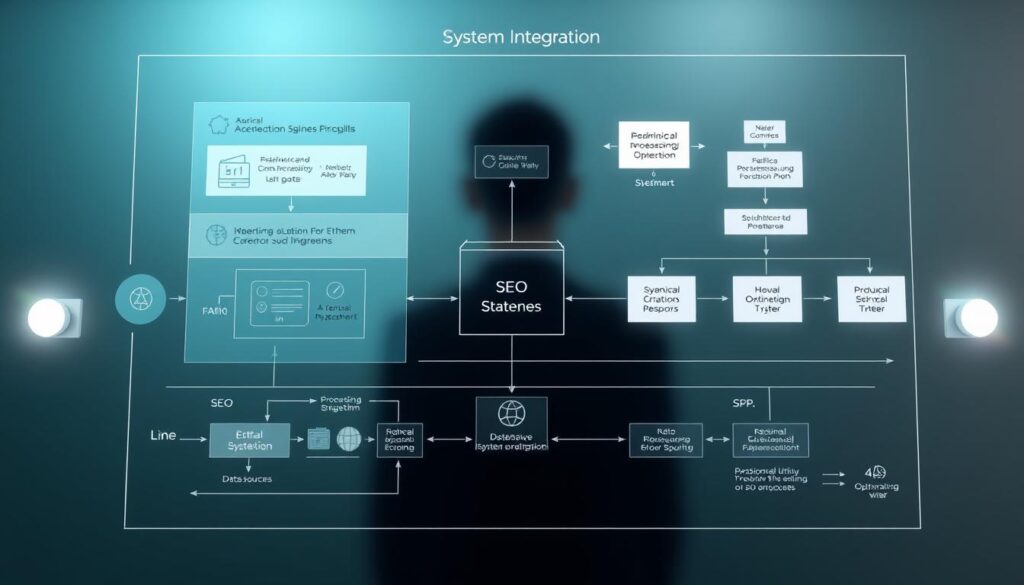Modern digital strategies now leverage autonomous systems capable of executing multi-step tasks with minimal oversight. These frameworks analyze data, adapt to algorithmic shifts, and optimize outcomes faster than manual methods. A 2024 McKinsey study found companies using such systems achieved 35% higher process efficiency and 20% faster decision-making within six months.
This evolution extends beyond basic automation. Advanced tools now handle keyword research, competitor benchmarking, and performance tracking across platforms. For instance, AI-driven solutions can identify emerging search trends while adjusting content strategies in real time. However, balancing automation with human oversight remains critical to maintain quality and compliance.
Governance frameworks ensure responsible use of these technologies, particularly when handling sensitive data or customer information. Organizations must prioritize transparency in how systems operate and make decisions. Properly structured workflows not only boost efficiency but also align with evolving industry standards.
Key Takeaways
- Autonomous systems improve operational efficiency by 35% and accelerate decision-making by 20%
- Modern tools manage end-to-end processes from keyword analysis to technical audits
- Human oversight ensures quality control and ethical compliance in automated workflows
- Data security protocols are essential when integrating AI with sensitive business systems
- Continuous adaptation to search algorithm updates drives long-term strategy success
Introduction to Ethical Agentic AI SEO Workflows

Contemporary approaches to digital optimization increasingly rely on self-governing frameworks that execute multi-phase strategies. These intelligent mechanisms adapt to algorithmic changes while maintaining alignment with core organizational values. Recent advancements enable comprehensive management of search visibility initiatives through interconnected decision-making processes.
Defining Modern Autonomous Optimization Systems
Autonomous optimization systems represent dynamic architectures where intelligent agents perform technical audits, analyze competitor tactics, and refine content strategies. Unlike conventional tools, these frameworks evaluate outcomes and adjust tactics without constant supervision. “The true power lies in their capacity to connect disparate tasks into cohesive campaigns,” notes a leading tech analyst.
Prioritizing Responsible Implementation
Organizations must balance efficiency with accountability when deploying automated solutions. Strict compliance measures ensure adherence to privacy laws like GDPR, particularly when handling sensitive customer data. For instance, financial institutions applying similar principles to financial compliance standards demonstrate successful integration of oversight protocols.
Robust authentication methods and encrypted communications form the foundation of secure implementations. Regular audits maintain transparency while preventing over-reliance on automated decisions. This approach builds consumer trust while delivering measurable performance improvements across search platforms.
Understanding Agentic Workflows in the SEO Context

Innovative frameworks in digital marketing leverage autonomous decision-making to streamline multi-step campaigns. These systems combine strategic planning with real-time adjustments, handling everything from keyword analysis to cross-channel optimization. Unlike conventional tools, they interpret objectives rather than just executing preset commands.
Defining Workflows for Modern Marketing
Advanced systems manage operations through four core components: planners that map strategies, executors that implement actions, memory modules storing historical data, and connectors integrating third-party tools. This architecture enables continuous adaptation to algorithm updates and market shifts.
A recent analysis of AI-driven marketing campaigns revealed three critical capabilities:
| Feature | Traditional Automation | Modern Workflows |
|---|---|---|
| Decision-Making | Rule-based execution | Context-aware adjustments |
| Adaptability | Limited scope changes | Dynamic strategy shifts |
| Data Processing | Single-source analysis | Multi-platform synthesis |
| Learning Capacity | Static performance | Progressive optimization |
These frameworks excel in managing diverse content types while maintaining brand consistency. Memory systems enable continuous improvement by analyzing past campaign results and competitor tactics. Marketing teams benefit from reduced manual tasks while maintaining strategic oversight.
One industry report notes: “The most effective systems balance autonomy with human-guided parameters, particularly when handling sensitive customer data.” This approach ensures compliance while capitalizing on operational efficiencies across digital channels.
Implementing Ethical Agentic AI SEO Workflows

Effective deployment of intelligent optimization systems demands careful planning across technical infrastructure and governance protocols. These frameworks reach full potential when connected to external resources through secure, scalable interfaces.
Toolkit and Integration Strategies
Modern implementations require four core components:
- Cloud-based infrastructure for scalable processing
- API management platforms handling data exchanges
- Context-aware memory databases
- Orchestration systems managing multi-tool coordination
Successful integration connects these elements to existing platforms like CMS software and analytics dashboards. A 2024 Forrester report found organizations using unified interfaces reduced implementation errors by 42% compared to piecemeal approaches.
Ensuring Regulatory Compliance and Security
Protection measures begin with role-based access controls and end-to-end encryption. Financial institutions applying similar financial compliance standards demonstrate how audit logs and intervention protocols maintain accountability.
Three critical safeguards prevent operational risks:
- Real-time monitoring of data transmission channels
- Automated compliance checks against regional regulations
- Fallback procedures activating during system anomalies
Regular penetration testing and access reviews ensure continued alignment with evolving security requirements while maintaining workflow efficiency.
Leveraging AI for Content Creation and Optimization
Digital content strategies are undergoing transformation through systems that manage creation and refinement processes. These platforms handle everything from initial research to final publication, adapting to audience interactions and platform requirements.
Streamlining Content Ideation through Autonomous Agents
Modern solutions analyze search patterns and competitor approaches to identify high-value topics. They cross-reference seasonal trends with brand objectives to create focused editorial plans. One platform reduced content planning time by 58% while increasing organic traffic by 33% in six months.
| Traditional Approach | Advanced Method |
|---|---|
| Manual keyword lists | Predictive search intent analysis |
| Static editorial calendars | Dynamic topic cluster generation |
| Single-platform focus | Cross-channel opportunity mapping |
Optimizing SEO Elements and Structured Data
Automated systems enhance visibility through technical improvements while maintaining readability. They implement schema markup and adjust page elements based on performance signals. “The best solutions balance technical precision with human-centric design,” states a recent industry white paper.
Key capabilities include:
- Real-time header tag adjustments matching search algorithm updates
- Automated internal linking based on content relevance scores
- Multi-variant testing for meta descriptions and CTAs
Platforms like those discussed in automated content scheduling tools demonstrate how structured data implementation can increase featured snippet appearances by 41%.
Data-Driven Planning and SEO Auditing Strategies
Strategic optimization in digital environments now demands systems that learn from historical patterns while adapting to real-time signals. These frameworks merge analytical precision with adaptive reasoning, creating self-improving cycles that refine strategies based on measurable outcomes.
Utilizing Analytics and Feedback Loops for Informed Decisions
Modern planning tools integrate multi-source data, combining traffic metrics with behavioral patterns and competitor benchmarks. This approach identifies underperforming assets while prioritizing high-impact opportunities. For example, advanced analytics integration can reveal hidden correlations between content updates and ranking improvements across devices.
| Aspect | Traditional Audits | Memory-Enhanced Systems |
|---|---|---|
| Issue Resolution | Single-cycle fixes | Pattern-based solutions |
| Data Utilization | Current snapshot | Historical trend analysis |
| Adjustment Speed | Manual implementation | Automated corrections |
Continuous feedback loops enable systems to test hypotheses and refine tactics. One platform reduced technical errors by 47% through automated crawl analysis paired with self-correcting protocols. “The ability to cross-reference live results with historical benchmarks creates smarter optimization pathways,” explains a recent industry report.
Comprehensive audit processes now evaluate backlink profiles alongside content relevance scores and page experience metrics. Memory-enhanced tools track resolution progress across multiple campaign cycles, identifying recurring bottlenecks. This method proved 29% more effective at sustaining ranking improvements than standard approaches in recent trials.
Automated reporting synthesizes complex analytics into visual dashboards, highlighting trends requiring human attention. When combined with strategic resource allocation, these insights help teams focus on high-value tasks rather than data interpretation. The result? Faster decision cycles and measurable performance gains across channels.
Technologies and Tools for Agentic SEO Workflows
Advanced technological architectures now power self-directed optimization processes through interconnected components. These frameworks combine computational power with adaptive learning to manage complex tasks across digital ecosystems. Cloud platforms like AWS and Google Cloud provide the backbone for processing large datasets, while specialized tools handle real-time decision-making.
Integration with CMS, APIs, and Third-Party Tools
Effective integration bridges autonomous systems with existing marketing stacks through secure API connections. Vector search engines such as Weaviate enable contextual analysis by mapping content relationships across platforms. This approach supports modern frameworks that synchronize data from CRMs, analytics dashboards, and content repositories.
Selecting the Right AI Tools for Seamless Workflow
Choosing appropriate technologies requires evaluating scalability, security protocols, and compatibility with current systems. Machine learning algorithms must adapt to evolving search patterns while maintaining brand guidelines. Solutions highlighted in industry analyses demonstrate how orchestration platforms balance automation with human oversight through intuitive interfaces.
Development teams prioritize tools offering real-time performance monitoring and error correction. This ensures continuous optimization while preserving strategic alignment across multi-channel campaigns. The right combination of tools and infrastructure drives measurable improvements in search visibility and operational efficiency.







